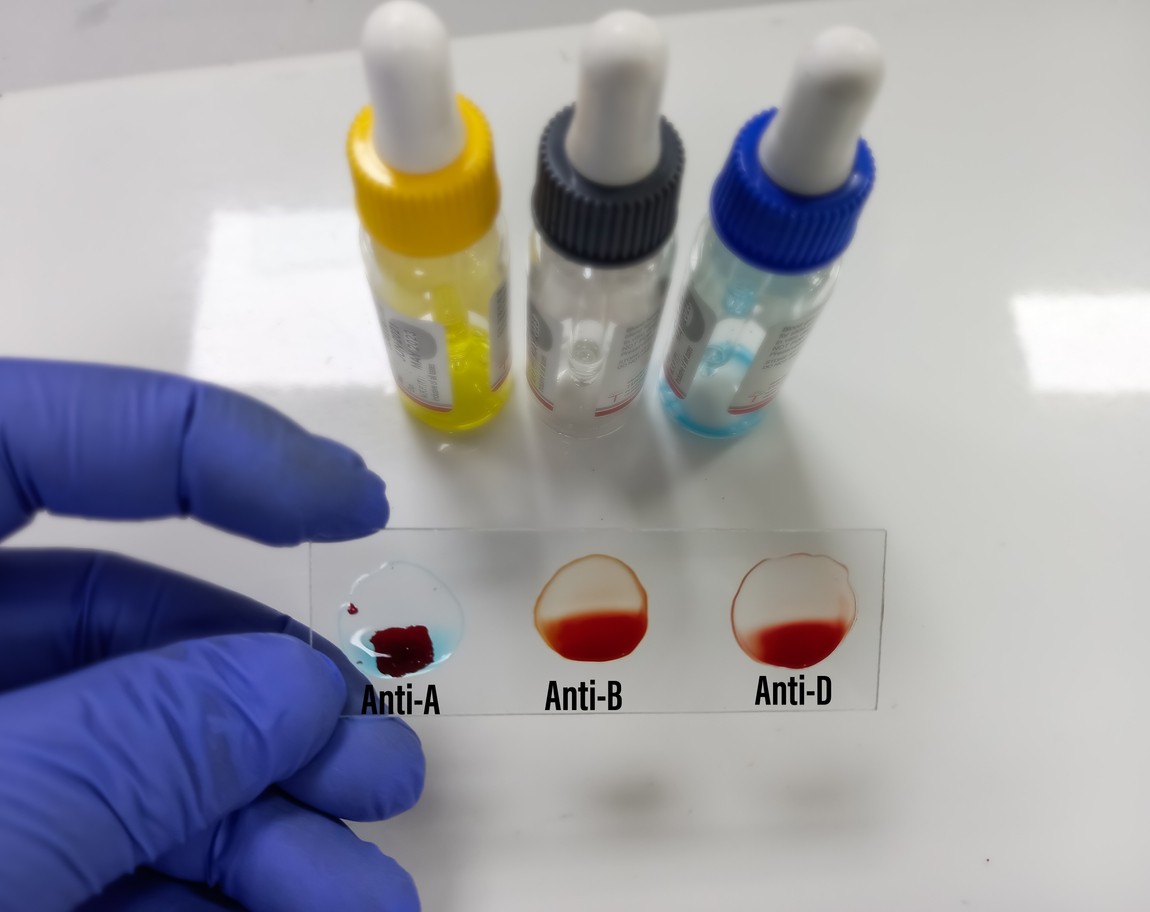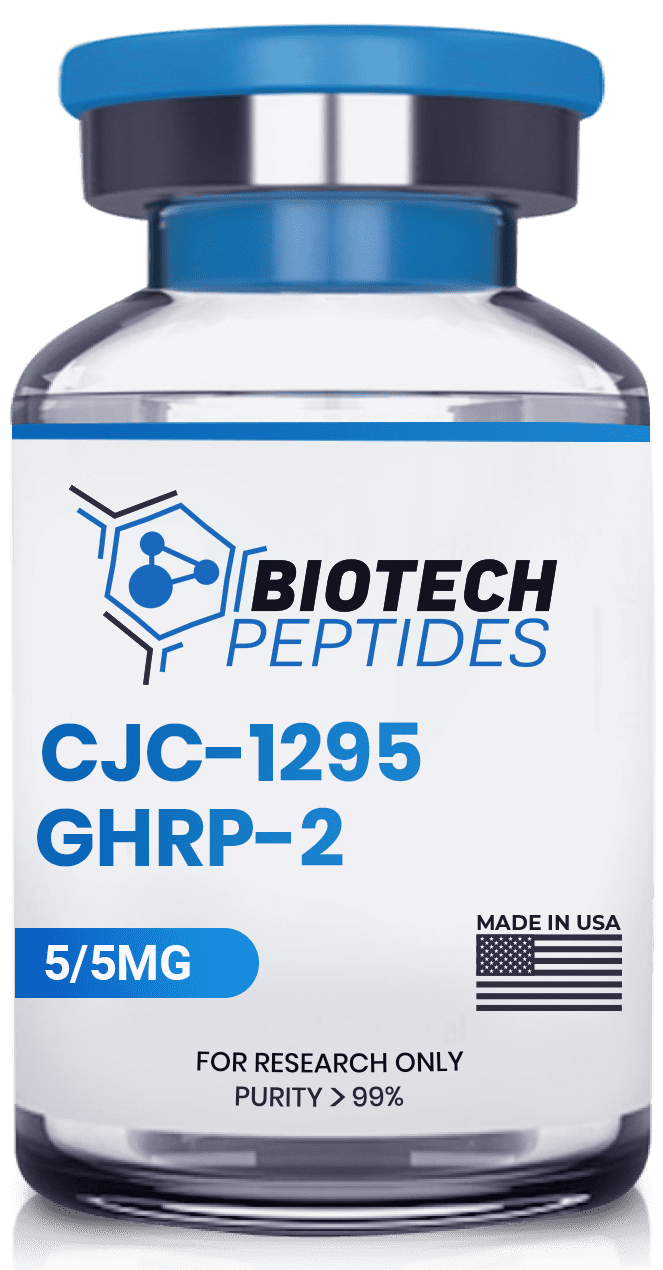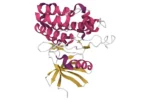CJC-1295 represents a molecular entity that appears to exhibit a binding affinity for the growth hormone-releasing hormone (GHRH) receptors, thereby potentially instigating the secretion of growth hormone by pituitary cells. Originating from GHRH 1-29, CJC-1295 encompasses the functional sequence composed of the initial 29 amino acids of GHRH. This peptide has been subject to tetra substitution and modification via the integration of a drug affinity complex (DAC) element. The DAC component binds to plasma proteins, apparently augmenting the pharmacokinetic properties of CJC-1295.[1]
Growth Hormone Releasing Peptide 2 (GHRP-2) represents a synthetic hexapeptide comprising of six amino acids. Studies suggest that this peptide binds to the ghrelin or growth hormone secretagogues 1a receptors (GHS-R1a), which are present within the hypothalamus and the pituitary gland. Consequently, GHRP-2 appears to stimulate the production of growth hormones in pituitary cells expressing the GHS-R1a receptor.[2]
By activating distinct receptors via separate biochemical pathways, these peptides are hypothesized to synergistically elevate GH release from the anterior pituitary, potentially surpassing the individual capacities of each peptide.
GHRP-2 and CJC 1295 Peptide Blend
Both GHRP-2 and CJC-1295 have undergone extensive evaluation in diverse animal models, and are speculated to yield favorable outcomes in terms of muscle hypertrophy and hyperplasia, cardiac function, and modulation of the immune system.
Furthermore, both peptides appear to exhibit the potential to reduce blood sugar levels while promoting the accrual of lean body mass at the expense of fat deposition. Notably, these peptides are recognized for their capacity to possibly induce fat loss through the amplification of metabolic processes.
This probable reduction in adipose tissue has been correlated with enhanced insulin sensitivity and notable advancements in cases of type 2 diabetes.
Research and Scientific Studies
Effect of GHRP-2 and CJC-1295 Blend on Growth Hormone Secretion
Scientific investigations suggest that GHRP-2 peptide appears to display considerable affinity towards the growth hormone secretagogues 1a receptor (GHS-R1a) located within the hypothalamus and the pituitary gland. In contrast, CJC-1295 appears to engage with the growth hormone-releasing hormone receptor (GHRH-R), specifically in the pituitary gland.
Research suggests that this amalgamated peptide blend may elevate plasma growth hormone (GH) levels, implying their potential to augment GH release. Moreover, sustained release dynamics of this blend appear to prolong the half-life of the peptides, possibly leading to the extension of GH secretion compared to the individual administration of peptides.
Studies have reported “basal GH levels may increase by 7.5-fold” contributing to an “overall 46% increase in GH secretion.”[3]
This phenomenon seems to regulate the pulsatile release of growth hormones, subject to negative feedback mechanisms, thereby potentially averting the development of supratherapeutic GH levels and their associated complications.[4]
Effect of GHRP-2 and CJC-1295 Blend on Fat Metabolism
Through distinct mechanisms, GHRP-2 and CJC-1295 peptides appear to stimulate GH release from pituitary cells, thereby facilitating fat loss. Scientific exploration indicates that CJC-1295 may exhibit a prolonged half-life compared to endogenous GHRH.
Growth hormone is considered to demonstrate anti-obesity effects through various mechanisms, including the promotion of lipolysis, enhanced utilization of fatty acids as an energy source, and heightened fat oxidation. The peptide blend, through growth hormone release, has reportedly exhibited increased glucose synthesis and decreased glucose uptake, resulting in heightened fat utilization and storage. Studies suggest that ghrelin-like peptides such as GHRP-2 may serve as a crucial hormonal signal of nutritional status to the somatotropic axis, playing a pivotal role in integrating energy balance with the growth process.[5]
Effect of GHRP-2 and CJC-1295 Blend on Osteoporosis
A clinical study conducted on eighty postmenopausal research models of osteoporosis undergoing estrogen therapy reported significant findings regarding the effects of growth hormone (GH) peptide (such as GHRP-2 and CJC 1295) on bone health.
The research subjects were randomized into groups receiving one of two concentrates of growth hormone or a placebo for 18 months in a double-blinded setup. The results indicated that the total body bone mineral content was notably higher in the higher concentration GH group at the 18-month mark. Over the course of 3 years, the experimental GH groups exhibited increases in total body and femoral neck bone mineral content. At the 4-year follow-up, the higher concentration GH group demonstrated a remarkable 14% increase in lumbar spine bone mineral content compared to the placebo.
Although no disparities in bone mineral density or content were observed between groups at the 5-year follow-up, the study suggests “GH (peptides) could be used as an anabolic agent in osteoporosis”[6], especially when combined with hormone replacement therapy and calcium/vitamin D supplementation.
Effect of GHRP-2 and CJC-1295 Blend on Immune System
Recent research underscores the intricate interplay between the neuroendocrine system and immune functions, illuminating a complex bidirectional relationship.
Notably, multiple lymphoid organs, including the thymus, spleen, and peripheral blood, have been identified as sites of growth hormone (GH) production, with the GH receptor expressed across various subpopulations of lymphocytes.
In vitro and animal studies indicate the possible role of GH in immunoregulation. GH peptides appear to stimulate the proliferation of T and B cells, facilitating immunoglobulin synthesis and promoting the maturation of myeloid progenitor cells. Moreover, GH also appears to modulate cytokine responses, thereby possibly influencing the intricate network of immune signaling.[7]
Interestingly, while GH deficiency (GHD) typically does not manifest as immunodeficiency, minor aberrations in immune function have been documented, albeit significantly less pronounced than those observed in animal models of GHD. This observation suggests the plausibility of local GH production within the immune system compensating for the absence of systemic GH.
Disclaimer: The products mentioned are not intended for human or animal consumption. Research chemicals are intended solely for laboratory experimentation and/or in-vitro testing. Bodily introduction of any sort is strictly prohibited by law. All purchases are limited to licensed researchers and/or qualified professionals. All information shared in this article is for educational purposes only.
References:
- Ionescu M, Frohman LA. Pulsatile secretion of growth hormone (GH) persists during continuous stimulation by CJC-1295, a long-acting GH-releasing hormone analog. J Clin Endocrinol Metab. 2006 Dec;91(12):4792-7. doi: 10.1210/jc.2006-1702. Epub 2006 Oct 3. PMID: 17018654. https://pubmed.ncbi.nlm.nih.gov/17018654/
- Yamamoto D, Ikeshita N, Matsubara T, Tasaki H, Herningtyas EH, Toda K, Iida K, Takahashi Y, Kaji H, Chihara K, Okimura Y. GHRP-2, a GHS-R agonist, directly acts on myocytes to attenuate the dexamethasone-induced expressions of muscle-specific ubiquitin ligases, Atrogin-1 and MuRF1. Life Sci. 2008 Feb 27;82(9-10):460-6. doi: 10.1016/j.lfs.2007.11.019. Epub 2007 Dec 5. PMID: 18191156. https://pubmed.ncbi.nlm.nih.gov/18191156/
- Ionescu M, Frohman LA. Pulsatile secretion of growth hormone (GH) persists during continuous stimulation by CJC-1295, a long-acting GH-releasing hormone analog. J Clin Endocrinol Metab. 2006 Dec;91(12):4792-7. doi: 10.1210/jc.2006-1702. Epub 2006 Oct 3. PMID: 17018654. https://pubmed.ncbi.nlm.nih.gov/17018654/
- Sigalos JT, Pastuszak AW. The Safety and Efficacy of Growth Hormone Secretagogues. Sex Med Rev. 2018 Jan;6(1):45-53. doi: 10.1016/j.sxmr.2017.02.004. Epub 2017 Apr 8. PMID: 28400207; PMCID: PMC5632578. https://www.ncbi.nlm.nih.gov/pmc/articles/PMC5632578/
- Laferrère B, Hart AB, Bowers CY. Obese subjects respond to the stimulatory effect of the ghrelin agonist growth hormone-releasing peptide-2 on food intake. Obesity (Silver Spring). 2006 Jun;14(6):1056-63. doi: 10.1038/oby.2006.121. PMID: 16861611; PMCID: PMC2824649. https://www.ncbi.nlm.nih.gov/pmc/articles/PMC2824649/
- Landin-Wilhelmsen K, Nilsson A, Bosaeus I, Bengtsson BA. Growth hormone increases bone mineral content in postmenopausal osteoporosis: a randomized placebo-controlled trial. J Bone Miner Res. 2003 Mar;18(3):393-405. doi: 10.1359/jbmr.2003.18.3.393. PMID: 12619921. https://pubmed.ncbi.nlm.nih.gov/12619921/
- Meazza C, Pagani S, Travaglino P, Bozzola M. Effect of growth hormone (GH) on the immune system. Pediatr Endocrinol Rev. 2004 Aug;1 Suppl 3:490-5. PMID: 16444180. https://pubmed.ncbi.nlm.nih.gov/16444180/







